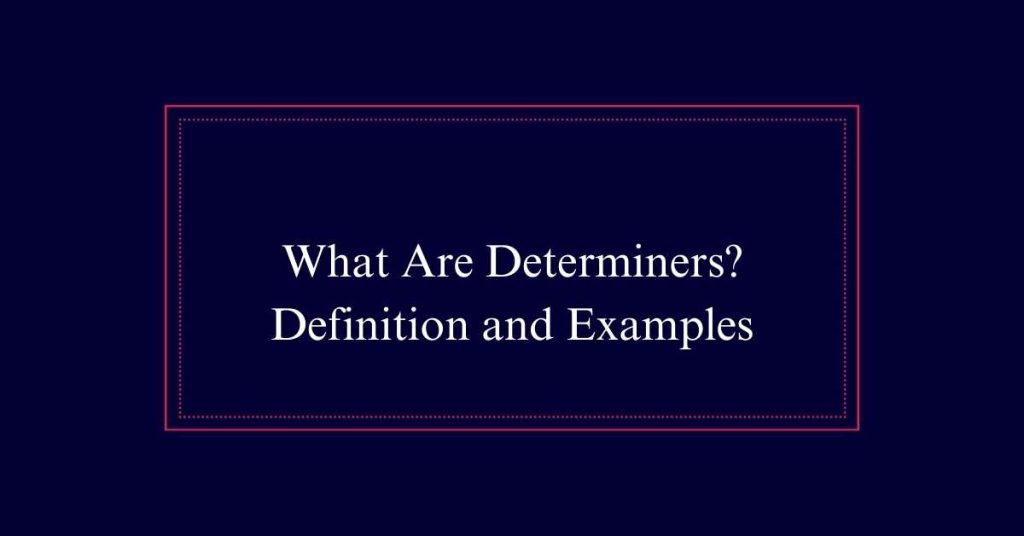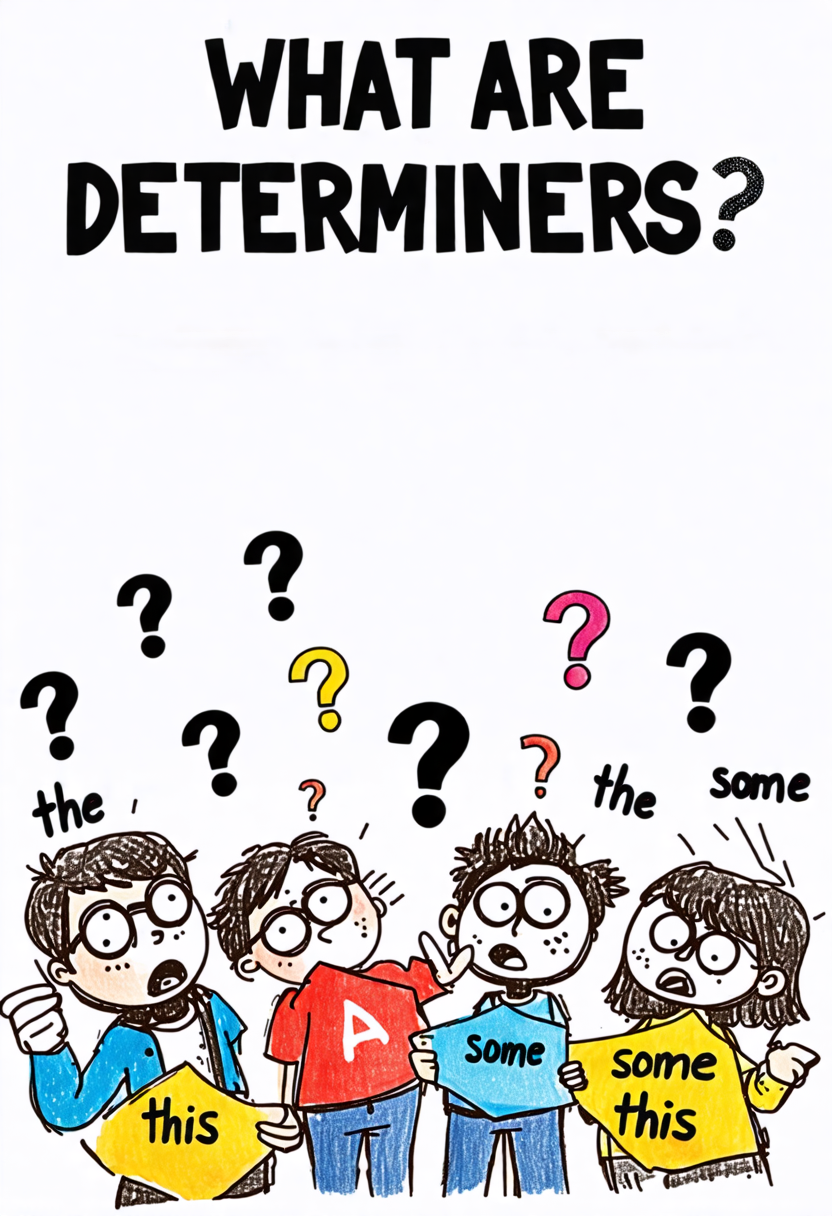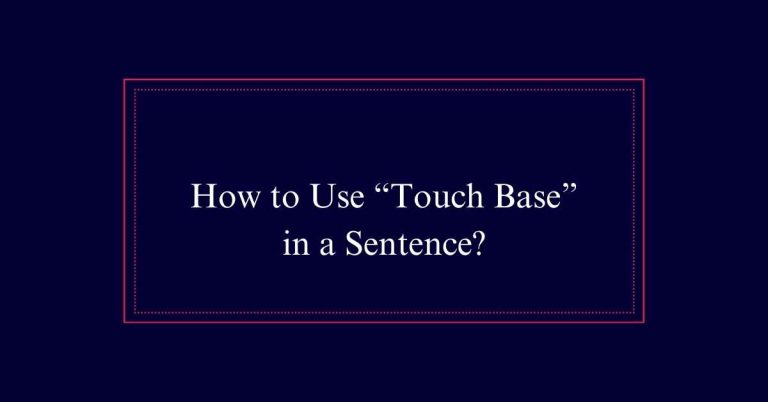What Are Determiners? Definition and Examples
Determiners are words used before nouns to provide context, specifying things like quantity, possession, or scope. They are essential for clear communication. Types of determiners include articles (a, an, the), demonstratives (this, that, these, those), possessives (my, your, his, her), and quantifiers (some, many, few).
For example, ‘the apple’ refers to a specific apple, while ‘an apple’ could be any apple. ‘This book’ specifies a nearby book, whereas ‘your book’ shows ownership.
Definition of Determiners
Determiners are words that modify nouns to provide context such as specificity, quantity, or ownership. They play an essential role in clarifying which particular noun is being referred to in a sentence.
For instance, determiners help distinguish between ‘a book’ (any book) and ‘the book’ (a specific book). They can also indicate ownership, as seen in ‘my car’ or ‘their house.’ Additionally, determiners specify quantity, like ‘some apples’ or ‘many people.’ This makes the noun’s meaning clearer and more precise.
Generally, determiners are placed before nouns and help set the framework for understanding the noun’s role and context in a sentence. Their usage is essential for clear and effective communication in both written and spoken language.
Types of Determiners
There are several types of determiners, each serving a unique function to clarify and specify nouns. Determiners include demonstratives, possessives, quantifiers, and distributives. Demonstratives like “this” and “those” point to specific items. Possessives such as “my” and “their” indicate ownership. Quantifiers like “some” and “many” provide information about quantity. Distributives, including “each” and “every,” refer to individual members within a group. These categories help provide context and specificity to nouns.
| Type | Examples |
|---|---|
| Demonstratives | This, that |
| Possessives | My, your, his, her |
| Quantifiers | Some, many, few |
| Distributives | Each, every |
Articles: Definite and Indefinite
Understanding the use of definite and indefinite articles is essential for accurate and clear communication.
The definite article ‘the’ refers to a specific noun that is known to the reader or listener. For instance, ‘the book on the table’ points to a particular book.
In contrast, indefinite articles ‘a’ and ‘an’ refer to a nonspecific noun. Use ‘a’ before words beginning with a consonant sound, such as ‘a cat,’ and ‘an’ before words starting with a vowel sound, like ‘an apple.’

These articles are vital in both written and spoken English to clarify whether you are referring to something specific or something general. Proper use of articles enhances understanding and prevents ambiguity in sentences.
Demonstrative Determiners
How do demonstrative determiners help specify which noun is being referred to?
Demonstrative determiners are essential for indicating specific nouns in a sentence. They help clarify which particular item or person is being mentioned, providing context and reducing ambiguity.
Examples of demonstrative determiners include:
- This: Refers to a singular noun that is close to the speaker.
- That: Refers to a singular noun that is further away from the speaker.
- These: Refers to plural nouns that are close to the speaker.
- Those: Refers to plural nouns that are further away from the speaker.
- Such: Emphasizes a particular quality of the noun.
Possessive Determiners
After understanding how demonstrative determiners clarify which noun is being mentioned, possessive determiners show ownership and relationships between nouns. These determiners include words like ‘my,’ ‘your,’ ‘his,’ ‘her,’ ‘its,’ ‘our,’ and ‘their.’ They indicate who owns something or to whom something is related. For example, ‘my book’ means the book belongs to me.
Here’s a simple table to illustrate possessive determiners:
| Possessive Determiner | Example | Meaning |
|---|---|---|
| My | My car | The car belongs to me |
| Your | Your pen | The pen belongs to you |
| His | His hat | The hat belongs to him |
| Her | Her bag | The bag belongs to her |
| Their | Their dog | The dog belongs to them |
Quantifiers as Determiners
Quantifiers are determiners that provide information about the quantity of a noun. They help to specify how much or how many of something there is. Quantifiers can be used with both countable and uncountable nouns.
Examples of quantifiers include:
- ‘Some’ and ‘any’ for an unspecified amount.
- ‘Many’ and ‘few’ for countable nouns.
- Much’ and ‘little‘ for uncountable nouns.
- ‘All’ and ‘none’ for the entirety of a group.
- ‘Several’ for more than a few but not many.
These words provide context and clarity in sentences.
For example, ‘Many students attended the lecture’ or ‘There is little water left.’
Distributive Determiners
Distributive determiners refer to individual members within a group, ensuring each member is addressed separately. Common examples include ‘each,’ ‘every,’ ‘either,’ and ‘neither.’ These words help to emphasize that actions or attributes apply to the members individually rather than collectively.
For example, in the sentence ‘Each student received a certificate,’ ‘each’ indicates that every single student, one by one, received a certificate. Similarly, ‘either’ and ‘neither’ are used to refer to one or the other of two options. For instance, ‘Either option is acceptable’ means that one of the two options can be chosen.
Placement of Determiners
Determiners typically appear before the nouns they modify, providing essential context. They help clarify which specific noun is being referred to and can indicate possession, quantity, or definiteness. The placement of determiners is vital for proper sentence structure.
- Articles: ‘A cat’ or ‘The cat’
- Demonstratives: ‘This book’ or ‘Those books’
- Possessives: ‘My car’ or ‘Her idea’
- Quantifiers: ‘Some apples’ or ‘Few options’
- Distributives: ‘Each student’ or ‘Every member’
These determiners must precede the noun they modify, ensuring clarity and precision in communication. They do not usually occur together and must agree in number and gender with the noun they modify. This placement helps readers and listeners understand the intended meaning.
Determiners With Adjectives
When determiners and adjectives are used together, determiners always precede the adjectives in a sentence. This is because determiners provide information about the noun, while adjectives describe its qualities.
For example, in the phrase ‘my new car,’ ‘my’ is a possessive determiner indicating ownership, and ‘new’ is an adjective describing the car. The correct order guarantees clarity and proper grammatical structure.
Determiners can include articles, possessives, quantifiers, and demonstratives. Adjectives can describe various attributes such as size, color, or condition. Correct placement of these elements is essential for conveying precise meaning.
Remember that in English syntax, determiners come first, followed by adjectives, and then the noun.
Common Determiner Rules
Understanding the common rules for using determiners is essential for mastering English grammar. Determiners are vital in providing clarity and specificity to nouns.
Here are some key rules to remember:
- Use ‘a’ or ‘an’ with singular countable nouns:
‘a cat,’ ‘an apple.’
- Use ‘the’ with specific or previously mentioned nouns:
‘the book on the table.’
- Use possessive determiners to show ownership:
‘my car,’ ‘your house.’
- Use quantifiers to indicate amount or quantity:
‘some water,’ ‘many people.’
- Distributive determiners refer to individual members of a group:
‘each student,’ ‘every child.’







